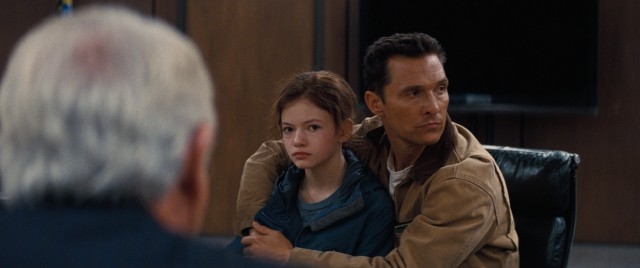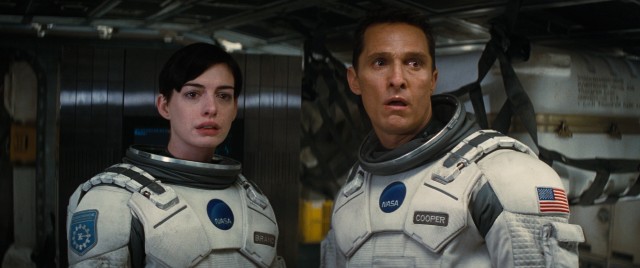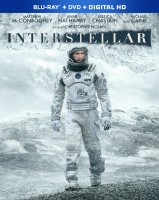Interstellar: Blu-ray + DVD + Digital HD Review
 |
Interstellar
Theatrical Release: November 5, 2014 / Running Time: 169 Minutes / Rating: PG-13 Director: Christopher Nolan / Writers: Jonathan Nolan, Christopher Nolan Cast: Matthew McConaughey (Cooper), Anne Hathaway (Amelia Brand), Jessica Chastain (Murph Cooper), Ellen Burstyn (Murph Cooper - older), John Lithgow (Donald), Michael Caine (Professor John Brand), Casey Affleck (Tom Cooper), Wes Bentley (Doyle), Bill Irwin (voice of TARS), Mackenzie Foy (Murph Cooper - 10 years), Topher Grace (Getty), David Gyasi (Romilly), Timothée Chalamet (Tom Cooper - 15 years), David Oyelowo (School Principal), Collette Wolfe (Ms. Hanley), William Devane (Williams), Josh Stewart (voice of CASE), Leah Cairns (Lois Cooper), Liam Dickinson (Coop Cooper), Matt Damon (Dr. Mann) |
 | Interstellar ranks 9th in our list of the Top 100 Movies of the Half-Decade (2010-2014). |
Buy Interstellar from Amazon.com: Blu-ray + DVD + Digital HD • DVD • Instant Video
After Christopher Nolan spent the better part of a decade making his trilogy of Batman films (Batman Begins, The Dark Knight, and The Dark Knight Rises), it'd be understandable if you forgot or assumed the writer-director forgot that he made his name on original ideas. The creative, nonlinear Memento announced Nolan and his younger brother Jonathan (credited with the short story on which the film was based) as visionary storytellers. The Nolans have never lost sight of that. While other filmmakers may have been spoiled and changed by a taste of such significant commercial success, the elder Nolan did not forget how he had risen to such power. Thus, after every Batman film, Nolan chose to make something different. Success in Gotham enabled the director to go bigger and bigger, from 2006's $40 million Victorian magician mystery The Prestige to 2010's $160 million original summer tentpole Inception. The budgets soared and so did the grosses, but not at the expense of artistic integrity. Inception drew rave reviews and a Best Picture Oscar nomination. The Prestige may have been in the running from the latter had the Oscars expanded their Best Picture field from five nominees before then. Speaking of that, the expansion is widely accepted as the Academy's response to the omission of The Dark Knight from 2008's nominees, which illustrates the impact of that sequel, at the time only the fourth movie to earn a billion dollars at the global box office.
With the Dark Knight trilogy unequivocally behind him and his involvement as producer of Zack Snyder's Man of Steel seemingly quite nominal, Nolan turned his attentions to another original project, this one his biggest by both cost and ambition. Interstellar, which the two brothers wrote and Christopher alone directed and produced, is a film of tremendous scope. It is inventive science fiction that is just as serious about its science as its fiction. It is a movie that gives deep and meaningful thought to humanity's relationship with its planet and what the future could hold based on some present-day concerns.
A sincere big picture view of life is not something you frequently find in today's motion pictures, especially not the kind that can afford television commercials and secure an engagement of over 3,000 theaters. And yet in Nolan, Hollywood trusts. The filmmaker probably had no difficulty assembling a cast full of in-demand talent or getting major studios Warner Bros. and Paramount to agree on a joint distribution deal and a production budget of $165 M, a price tag that only about 65 movies have previously exceeded.
Interstellar opens in the near-future, where we meet a widowed farmer named Cooper (Matthew McConaughey), his two children, daughter Murphy (Mackenzie Foy) and son Tom (Timothée Chalamet), and Cooper's father-in-law (John Lithgow). Humanity seems doomed, as blight has caused crops to die off. The most recent casualty is wheat, which leaves little more than corn to sustain the human race. The blight has also produced regular dust storms, which arrive without warning and are barely deterred by face masks and sealed windows.
Murphy claims a ghost is in her room, something the rest of her family dismisses on the basis of science. Upon looking into the matter, though, Cooper finds some credence in the girl's theory that this otherworldly presence has been communicating by Morse code. He deduces that the sounds are actually binary code consisting of a location's coordinates. Cooper drives to the prescribed destination and discovers a secure, top-secret headquarters for what remains of NASA, including his old professor Brand (Michael Caine) and Brand's daughter Amelia (Anne Hathaway). Learning that NASA has been plotting to save humanity from extinction, Cooper soon signs on for an imminent mission which will have him, Amelia, a couple of robots, and a few others journeying through a wormhole and visiting three potentially inhabitable planets where explorers have been stationed and sending data.
Cooper bids farewell to his family for a greater good on the hope that his children will have a place to live. The expedition is full of surprises, though, and keeps Cooper away from Earth longer than he expects, as he encounters such phenomenon as a black hole's gravitational pull.
Interstellar was poised to be taken as more than a movie from the moment it was announced. To an even greater degree than past Nolan films, this production was wrapped in secrecy. Plot details were nowhere to be found. Teaser trailers shed minimal light on the story. Theatrical release arrived in early November in atypical fashion. Nolan had directions on everything from what critics could disclose to how cast members with appearances in multiple films managed promotional appearances. No guests were allowed in the only local critics' screening available to me, so I did not get to review the film. Meanwhile, Nolan decided to exploit some of the power and influence his movies had won him to advocate for good old-fashioned film. With Paramount's apparent blessing, the filmmaker allowed domestic theaters still equipped to exhibit 35mm and 70mm film to do so two days earlier than those which had upgraded to all-digital distribution.
Despite all these unconventional touches, Interstellar still had to be received and judged like any other film. All the anticipation, hype, mystery, and intrigue surrounding the film could not elevate it to a first place opening weekend. It had to settle for a not too distant second place behind Disney's animated adventure Big Hero 6. That somewhat rude awakening was only the first sign that this movie and its maker were not above typical show business concerns. Interstellar would perform exceptionally well for an entirely original movie, especially in foreign markets, which accounted for nearly three-fourths of the film's global gross. Nonetheless, domestically, it was no Gravity, the obvious benchmark for a technically dazzling original sci-fi blockbuster.
Arriving in the fall of 2014, a year after Gravity cast its spell on moviegoers en route to its technical category sweep of the Academy Awards, demanded that Interstellar be compared to Alfonso Cuarón's Best Picture runner-up. At a cursory glance, the two movies may seem similar, for both involve challenging space travels for a person with their children on their mind. Both films are expensive, dynamic, PG-13 rated, and visually stunning, but the comparisons kind of end there. Cuarón's 91-minute 3D film is a lean survival story that barely qualifies as sci-fi; Nolan's nearly 3-hour 2D film is an epic odyssey designed to explore the nature, sustainability, and effects of human existence as well as the vast, largely unknown universe around us.
Like most people, I enjoyed Gravity as an exciting thrill ride. I found Interstellar to be a much richer and more substantial experience.
Though there are echoes of M. Night Shyamalan's Signs and Robert Zemeckis' Contact, Interstellar most resembles Stanley Kubrick's revered 2001: A Space Odyssey in scope and beauty. Nolan has never lacked confidence and he's had enough success to make him an easy target for detractors to dress down. That isn't to say that the tepid and cold reviews published on Interstellar were personal in nature or intended to be contrarian. It's just a fact that it's easier to criticize an established, successful artist you consider complacent than a fresh, original voice with no prior work to influence you. Any director who finds 7 of his first 9 features ranked among the 110 greatest movies ever on IMDb before age 45, even one as private and guarded as Nolan, invites some backlash.
Even if I can appreciate certain complaints that have been hurled at Interstellar, I cannot agree with them. The film excels as far too few new ones do. As far as sensory feasts go, others like Gravity are comparable. But Interstellar marries its delightful visuals (shot by Swiss cinematographer Hoyte Van Hoytema, taking over from Nolan's go-to DP-turned-director Wally Pfister) and hypnotic organ-based score (from Dark Knight's Hans Zimmer) to a story that engages and stimulates. The Nolan brothers' screenplay is smart, thoughtful, provocative, and moving. It remains those things even in action scenes that are drowned out by sound effects and score. Once you're hooked, you're hooked and you're certain to want to see the unexpected places this will take you.
An improvement on Nolan's past original films, Interstellar succeeds with heart and humanity, two ingredients you don't often find in today's genre output. McConaughey could not ask for a better project with which to follow his Oscar win. He gives the protagonist everything the film needs. Other talented actors, from Nolan's good luck charm Michael Caine to such pros as Jessica Chastain, Casey Affleck, and (spoiler alert?) Matt Damon make the most of their screentime. Even Hathaway, who extends the director's streak of casting unlikable leading ladies, is tolerable as she was in her last Nolan film.
One of Nolan's more inspired decisions is to keep CGI to a minimum. The filmmaker reminds us of the power of practical, from timeless production design to exotic filming locations to the use of real "dust" clouds. While Interstellar demands nearly three hours of your time, it is no chore. Even on a second viewing, I found it moves faster at 169 minutes than 2001 does at 149, to give but one example.
A little more than a month after going underappreciated at the Academy Awards, where it only won for Visual Effects from five minor technical nominations (even 2001 was nominated for Director and Screenplay) and five days before Easter, Interstellar reached North American stores from Paramount Home Entertainment, who release it as a barebones DVD and the Blu-ray + DVD + Digital HD combo pack reviewed here. VIDEO and AUDIO
If you've been following Christopher Nolan's career closely, then you should know what to expect in terms of Interstellar's Blu-ray presentation: sonic blasts and aspect ratio changes. The film frequently alternates between 1.78:1 and 2.40:1 widescreen. The narrower of those present scenes that were shot on IMAX cameras. There is a lot of that, sometimes for shots as short as two seconds. The varying dimensions may annoy some, but the clarity of these bits is truly stunning. Interstellar was obviously shot on film rather than digital cameras and you can tell from the way that parts of certain shots are out of focus, lightly grainy, and ever so slightly imperfect. The BD's picture is highly pleasing.
The default English soundtrack is presented in 5.1 DTS-HD master audio. Sound was a hot topic on this film's theatrical exhibitions, with enough expressing frustration at volume levels for some theaters to print signs and Nolan to defend the design (which went on to garner Sound Mixing and Sound Editing Oscar nominations). That issue does not disappear for home video. The mix gets very, very loud at times, requiring frequent volume level adjustments if your home theater could potentially disturb neighbors or people in your home. While I appreciate Nolan's vision enough to respect the deliberate peaks and valleys, I do kind of wish there was a more consistent alternate soundtrack for late night and remote-free viewing. Thankfully, the mix does a tremendous job of presenting Zimmer's entrancing, excellent score, whose church organ sound seems appropriate, given that this will strike some viewers as a practically religious experience.
For whatever reason, the DVD does not feature the aspect ratio changes on scenes shot in IMAX. The majority of the film remains in 2.40:1, with the handful of interwoven documentary scenes pillarboxed within that frame.
BONUS FEATURES, MENUS, PACKAGING and DESIGN
Bonus features are relegated to a second Blu-ray Disc, which ensures that the feature presentation can get all the space it needs and more. Divided into three listings, they are all encoded in HD.
"The Science of Interstellar" (50:20) is a documentary narrated by Matthew McConaughey which considers the relevant scientific ideas presented in the movie. It sheds a light on the contributions of astrophysicist Kip Thorne, an executive producer on the film, and other scientific advisors, with good footage of Christopher Nolan consulting them. Keeping promotion to a minimum while sincerely covering topics like the search for inhabitable planets, Inside Interstellar consists of fourteen featurettes you'll wish were joined with a "Play All" option. "Plotting an Interstellar Journey" (7:49) starts with the film's conception by producer Lynda Obst and astrophysicist Kip Thorne, deciding on a depiction of the future, and shooting in IMAX. "Life on Cooper's Farm" (9:43) contemplates the Calgary location of the family home and cornfield with a mountain view. "The Dust" (2:38) discusses the blowing around the safe material to great dramatic effect. "TARS and CASE" (9:27) explores the film's "The Space Suits" (4:31) is a costume design piece revealing the thinking that went into the heavy, functional NASA suits created for and worn in the film. "The Endurance" (9:24) looks at the film's main ship, with a little tour of the set and explanation of its components. "Shooting in Iceland: Miller's Planet/Mann's Planet" (12:42) describes and depicts filming in the extremes of the remote Nordic island, where production utilized glaciers and other exotic geography amidst avalanches. "The Ranger and the Lander" (12:20) reflects on the secondary spacecrafts, their features, and their filming challenges. "Miniatures in Space" (5:29) explains some of the alternative techniques that Nolan and company used on the film instead of CGI in the name of timeless realism.
"The Simulation of Zero-G" (5:31) examines how the filmmakers simulated zero gravity with harnesses and training. The technical "Celestial Landmarks" (13:22) gets into the space visuals, specifically the wormhole and black hole. "Across All Dimensions and Time" (9:02) addresses visualizing the big climactic tesseract setting. Finally, a Trailers section preserves Interstellar's teaser (1:52) and three theatrical trailers (2:34, 2:35, 2:29), all of which maintain some degree of ambiguity. Their inclusion is pretty rare and especially rewarding since they include footage not in the film itself.
The DVD gets no bonus features, either here or the version sold on its own. That appears to be Paramount's current policy unfortunately and isn't another Nolan-requested peculiarity.
The last cool extra is found inside the case: it is an IMAX film cell from an actual 70mm film print. Measuring three inches wide, the cell you get could come from any part of the film. Mine features both Hathaway and McConaughey suited up but unhelmeted aboard their spacecraft. What a nifty inclusion which reflects Nolan's love of film. An insert supplying directions and a redemption code for the Digital HD copy of the film included with the purchase (good for UltraViolet, iTunes, and Googleplay) joins the three boringly labeled discs inside the slipcovered keepcase.
While the movie Blu-ray opens with streaming trailers that may or may not finish all the way through, the DVD presents currently some of the same previews without the likelihood of technical difficulty. Repeated from the "Previews" listing on that disc's main menu, these advertise Terminator: Genisys, The Gambler, and Selma.
The simple menus settle on a title logo (adapted from marketing rather than the plain credits) after a very brief opening shot and score excerpt set the scene. The Blu-ray lets you set bookmarks on the film, but does not make resuming playback any easier than that.
CLOSING THOUGHTS
Having seen most of what 2014 had to offer, I feel comfortable calling Interstellar the best film of last year. Christopher Nolan applies his signature flair to a powerful story about life, the universe and everything. The film's technical wonderment would be enough to warrant interest, but attached to strong performances and potent writing it makes for one of the definitive cinematic experiences of our time. I feel like this will widely be appreciated as a great piece of art at some point in the near-future.
Paramount's Blu-ray combo pack would be easy to recommend on the basis of the film and its high quality presentation (the picture is top-notch, even if the sound is somewhat maddening by design). The bonus disc with three hours of content and a collectible IMAX frame only add value and cement this as the best home video release of 2015's first quarter.
Buy Interstellar from Amazon.com: Blu-ray + DVD + Digital HD / DVD / Instant Video
|
Related Reviews:
DVDizzy.com | DVD and Blu-ray Reviews | New and Upcoming DVD & Blu-ray Schedule | Upcoming Cover Art | Search This Site
DVDizzy.com Top Stories:
Directed by Christopher Nolan: The Dark Knight Rises • Following • The Prestige
New: The Hobbit: The Battle of the Five Armies • Into the Woods • The Imitation Game
Matthew McConaughey: Dallas Buyers Club • The Wolf of Wall Street | Matt Damon: Elysium
Jessica Chastain: Zero Dark Thirty • Take Shelter • The Tree of Life • The Help • Mama
Michael Caine: The Muppet Christmas Carol • Stonehearst Asylum | Anne Hathaway: The Princess Diaries
Guardians of the Galaxy • Dawn of the Planet of the Apes • Captain America: The Winter Soldier • X-Men: Days of Future Past
Gravity • 2001: A Space Odyssey • Sunshine • Transcendence • Hugo
Text copyright 2015 DVDizzy.com. Images copyright 2014 Paramount Pictures, Warner Bros. Pictures, Legendary Pictures, Syncopy, Lynda Obst Productions,
and 2015 Paramount Home Entertainment. Unauthorized reproduction prohibited.










